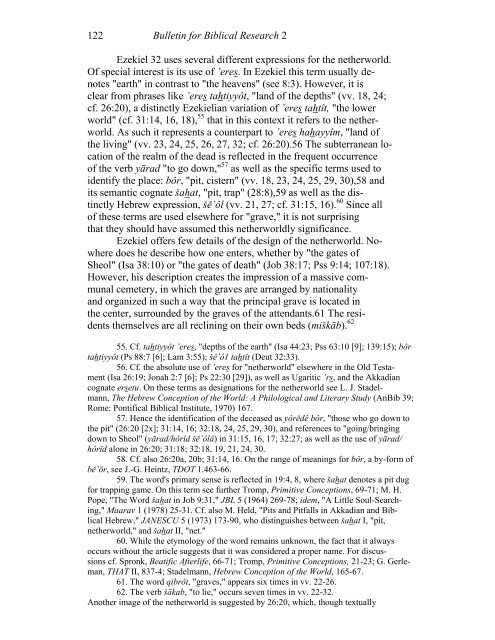Beyond the Grave - Institute for Biblical Research
Beyond the Grave - Institute for Biblical Research
Beyond the Grave - Institute for Biblical Research
You also want an ePaper? Increase the reach of your titles
YUMPU automatically turns print PDFs into web optimized ePapers that Google loves.
122 Bulletin <strong>for</strong> <strong>Biblical</strong> <strong>Research</strong> 2<br />
Ezekiel 32 uses several different expressions <strong>for</strong> <strong>the</strong> ne<strong>the</strong>rworld.<br />
Of special interest is its use of ’eres. In Ezekiel this term usually de-<br />
notes "earth" in contrast to "<strong>the</strong> heavens" (see 8:3). However, it is<br />
clear from phrases like ’eres tahtiyyôt, "land of <strong>the</strong> depths" (vv. 18, 24;<br />
cf. 26:20), a distinctly Ezekielian variation of ’eres tahtît, "<strong>the</strong> lower<br />
world" (cf. 31:14, 16, 18), 55 that in this context it refers to <strong>the</strong> ne<strong>the</strong>r-<br />
world. As such it represents a counterpart to ’eres hahayyîm, "land of<br />
<strong>the</strong> living" (vv. 23, 24, 25, 26, 27, 32; cf. 26:20).56 The subterranean lo-<br />
cation of <strong>the</strong> realm of <strong>the</strong> dead is reflected in <strong>the</strong> frequent occurrence<br />
of <strong>the</strong> verb yārad "to go down," 57 as well as <strong>the</strong> specific terms used to<br />
identify <strong>the</strong> place: bôr, "pit, cistern" (vv. 18, 23, 24, 25, 29, 30),58 and<br />
its semantic cognate šahat, "pit, trap" (28:8),59 as well as <strong>the</strong> dis-<br />
tinctly Hebrew expression, šĕ’ôl (vv. 21, 27; cf. 31:15, 16). 60 Since all<br />
of <strong>the</strong>se terms are used elsewhere <strong>for</strong> "grave," it is not surprising<br />
that <strong>the</strong>y should have assumed this ne<strong>the</strong>rworldly significance.<br />
Ezekiel offers few details of <strong>the</strong> design of <strong>the</strong> ne<strong>the</strong>rworld. No-<br />
where does he describe how one enters, whe<strong>the</strong>r by "<strong>the</strong> gates of<br />
Sheol" (Isa 38:10) or "<strong>the</strong> gates of death" (Job 38:17; Pss 9:14; 107:18).<br />
However, his description creates <strong>the</strong> impression of a massive com-<br />
munal cemetery, in which <strong>the</strong> graves are arranged by nationality<br />
and organized in such a way that <strong>the</strong> principal grave is located in<br />
<strong>the</strong> center, surrounded by <strong>the</strong> graves of <strong>the</strong> attendants.61 The resi-<br />
dents <strong>the</strong>mselves are all reclining on <strong>the</strong>ir own beds (miškāb). 62<br />
55. Cf. tahtiyyôt ’eres, "depths of <strong>the</strong> earth" (Isa 44:23; Pss 63:10 [9]; 139:15); bôr<br />
tahtiyyôt (Ps 88:7 [6]; Lam 3:55); šê’ô1 tahtît (Deut 32:33).<br />
56. Cf. <strong>the</strong> absolute use of ’eres <strong>for</strong> "ne<strong>the</strong>rworld" elsewhere in <strong>the</strong> Old Testa-<br />
ment (Isa 26:19; Jonah 2:7 [6]; Ps 22:30 [29]), as well as Ugaritic ’rs, and <strong>the</strong> Akkadian<br />
cognate ersetu. On <strong>the</strong>se terms as designations <strong>for</strong> <strong>the</strong> ne<strong>the</strong>rworld see L. J. Stadel-<br />
mann, The Hebrew Conception of <strong>the</strong> World: A Philological and Literary Study (AnBib 39;<br />
Rome: Pontifical <strong>Biblical</strong> <strong>Institute</strong>, 1970) 167.<br />
57. Hence <strong>the</strong> identification of <strong>the</strong> deceased as yôrĕdê bôr, "those who go down to<br />
<strong>the</strong> pit" (26:20 [2x]; 31:14, 16; 32:18, 24, 25, 29, 30), and references to "going/bringing<br />
down to Sheol" (yārad/hôrîd šĕ’ôlâ) in 31:15, 16, 17; 32:27; as well as <strong>the</strong> use of yārad/<br />
hôrîd alone in 26:20; 31:18; 32:18, 19, 21, 24, 30.<br />
58. Cf. also 26:20a, 20b; 31:14, 16. On <strong>the</strong> range of meanings <strong>for</strong> bôr, a by-<strong>for</strong>m of<br />
bĕ’ōr, see J.-G. Heintz, TDOT 1.463-66.<br />
59. The word's primary sense is reflected in 19:4, 8, where šahat denotes a pit dug<br />
<strong>for</strong> trapping game. On this term see fur<strong>the</strong>r Tromp, Primitive Conceptions, 69-71; M. H.<br />
Pope, "The Word šahat in Job 9:31," JBL 5 (1964) 269-78; idem, "A Little Soul-Search-<br />
ing," Maarav 1 (1978) 25-31. Cf. also M. Held, "Pits and Pitfalls in Akkadian and Bib-<br />
lical Hebrew," JANESCU 5 (1973) 173-90, who distinguishes between šahat I, "pit,<br />
ne<strong>the</strong>rworld," and šahat II, "net."<br />
60. While <strong>the</strong> etymology of <strong>the</strong> word remains unknown, <strong>the</strong> fact that it always<br />
occurs without <strong>the</strong> article suggests that it was considered a proper name. For discus-<br />
sions cf. Spronk, Beatific Afterlife, 66-71; Tromp, Primitive Conceptions, 21-23; G. Gerle-<br />
man, THAT II, 837-4; Stadelmann, Hebrew Conception of <strong>the</strong> World, 165-67.<br />
61. The word qibrôt, "graves," appears six times in vv. 22-26.<br />
62. The verb šākab, "to lie," occurs seven times in vv. 22-32.<br />
Ano<strong>the</strong>r image of <strong>the</strong> ne<strong>the</strong>rworld is suggested by 26:20, which, though textually

















